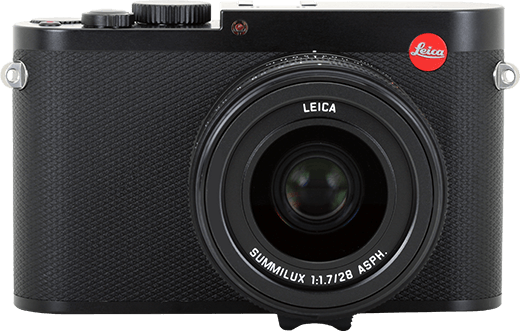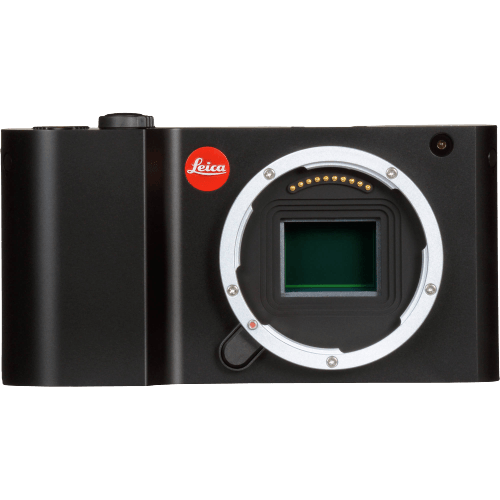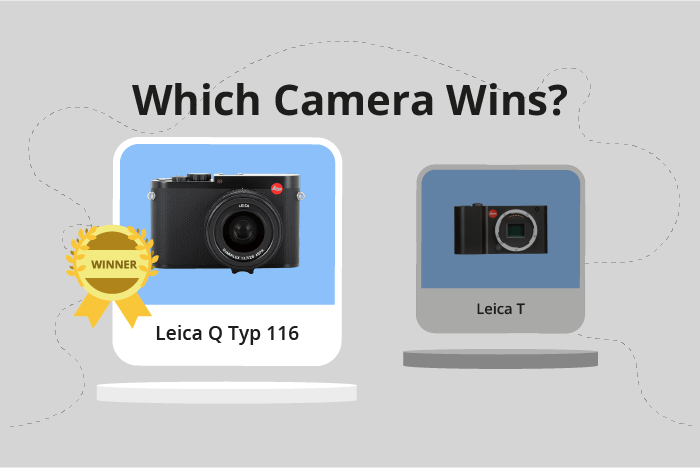Leica Q Typ 116 vs T Comparison
Leica Q Typ 116

Leica T

The Leica Q Typ 116 outperforms the Leica T with a score of 64/100 compared to 52/100. Both cameras share similarities in their announcement years, with the Leica Q Typ 116 in 2015 and the Leica T in 2014. Additionally, they have a similar size, with the Leica Q Typ 116 measuring 130x80x93mm and the Leica T at 134x69x33mm.
The Leica Q Typ 116 excels due to its compact camera type and superior score. It is heavier at 640g, but this often indicates better build quality. Its launch price of $4250 is higher than the Leica T’s $1850, reflecting its premium features.
On the other hand, the Leica T has the advantage of being a mirrorless camera, resulting in a lighter weight of 384g. This makes it more portable and easier to handle for extended periods. Despite its lower score, the Leica T still offers quality performance at a more affordable price point.
Considering the differences in scores, camera types, and prices, potential buyers should weigh their specific needs and preferences when choosing between the Leica Q Typ 116 and the Leica T.
Leica Q Typ 116 vs T Overview and Optics
The Leica Q Typ 116 emerges as the winner in the optics comparison, scoring 72/100, while the Leica T scores 51/100. This difference of 21 points showcases the superior optical performance of the Leica Q Typ 116.
Both cameras share common specifications, such as the CMOS sensor type, the Maestro II processor, and the lack of image stabilization. However, the Leica Q Typ 116 surpasses the Leica T in several key areas. The Q Typ 116 has a higher megapixel count of 24.2, compared to the Leica T’s 16, allowing for more detailed images. The Q Typ 116 also boasts a faster shooting speed of 10, doubling the Leica T’s 5. Additionally, the Q Typ 116 has a full-frame sensor, contributing to better image quality and low-light performance, as evidenced by its higher DXOMARK score of 85, compared to the Leica T’s 75.
The Leica T does have an advantage in lens versatility, as it features a Leica T lens mount, enabling users to change lenses. Conversely, the Leica Q Typ 116 has a fixed lens mount, limiting users to the built-in lens. This flexibility may be appealing to some photographers who require different lenses for various shooting scenarios.
Taking these factors into account, the Leica Q Typ 116 outperforms the Leica T in terms of optics, offering superior image quality, faster shooting speeds, and better low-light performance. However, the Leica T provides the benefit of lens versatility, which may be important to some users. Ultimately, the choice between these two cameras depends on individual preferences and shooting requirements.
Leica Q Typ 116 vs T Video Performance
The Leica Q Typ 116 outperforms the Leica T in video capabilities, with a video score of 70/100 compared to the Leica T’s 43/100. Both cameras share some common specifications, such as having a maximum video resolution of Full HD and video dimensions of 1920 x 1080. However, there are key differences that make the Leica Q Typ 116 the superior choice for video recording.
The Leica Q Typ 116 has a higher maximum video frame rate of 60fps, while the Leica T only offers 30fps. This means that the Leica Q Typ 116 can capture smoother and more detailed video, particularly in fast-moving scenes or when recording sports events. Additionally, the Leica Q Typ 116 has built-in time-lapse functionality, allowing users to create stunning time-lapse videos without the need for external software or equipment.
On the other hand, the Leica T does not have any significant advantages in video capabilities over the Leica Q Typ 116. Its lower video score and lack of time-lapse functionality make it a less suitable choice for those who prioritize video recording in their camera selection.
Considering the differences in video capabilities, the Leica Q Typ 116 is clearly the superior option between the two cameras. Its higher video score, faster frame rate, and built-in time-lapse functionality make it an ideal choice for users who value high-quality video recording. In contrast, the Leica T lags behind in this regard and may not be the best choice for those seeking a camera with exceptional video performance.
Leica Q Typ 116 vs T Features and Benefits
The Leica T emerges as the winner in the features comparison by a slight margin, scoring 59 out of 100 points, while the Leica Q Typ 116 scores 57 points. Both cameras share some common specifications, including a touchscreen and the absence of a flip screen, GPS, and Bluetooth. However, there are key differences that make one camera better than the other in certain aspects.
The Leica T has a larger screen size of 3.7 inches, compared to the Leica Q Typ 116’s 3-inch screen. Additionally, the Leica T’s screen resolution is higher at 1,300,000 dots, providing a clearer and more detailed display than the Leica Q Typ 116’s 1,040,000 dots. The presence of WIFI in the Leica T also gives it an advantage, allowing for easier file transfers and remote control capabilities.
On the other hand, the Leica Q Typ 116 does not offer any significant advantages over the Leica T in terms of features. Both cameras lack a flip screen, GPS, and Bluetooth, and they both have touchscreens. The only notable difference is the slightly smaller screen size and lower resolution, which do not contribute to the overall performance of the camera.
Taking these factors into account, the Leica T’s larger screen size, higher resolution, and WIFI connectivity make it the better choice when it comes to features. Although the Leica Q Typ 116 falls short in this comparison, it should not be dismissed entirely, as it may excel in other aspects such as optics and video performance. Ultimately, the choice between these two cameras depends on the individual’s priorities and preferences in a camera’s features.
Leica Q Typ 116 vs T Storage and Battery
The Leica T triumphs over the Leica Q Typ 116 in storage and battery with a score of 24 to 16. Both cameras share similarities, as each has one memory card slot and accepts SD, SDHC, and SDXC cards. Neither camera offers USB charging capabilities.
The Leica T outperforms the Leica Q Typ 116 in battery life, providing 400 shots per charge compared to the latter’s 300 shots. This is due to the Leica T’s BP-DC13 battery type, which surpasses the Leica Q Typ 116’s BP-DC12 battery. However, the Leica Q Typ 116 does not have any advantage over the Leica T in this category.
Considering the storage and battery performance, the Leica T is the preferable choice due to its longer battery life, while both cameras share similar storage capabilities.
Leica Q Typ 116 vs T – Our Verdict
Are you still undecided about which camera is right for you? Have a look at these popular comparisons that feature the Leica Q Typ 116 or the Leica T:

